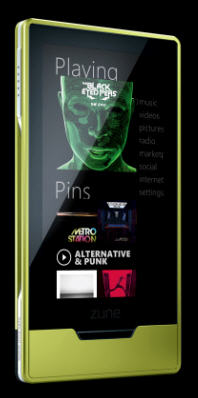Microsoft Zune HD: Going beyond the specs

On September 15, Microsoft and its retail partners began selling the Zune HD in the U.S. Lots of sites have hands-on reviews, photos and feature details about the players and the accompanying Zune 4.0 software beyond what's already leaked to the Web over the past few months.

To Microsoft, the Zune is more than a media player, Farrell said. Microsoft is fully aware that, currently, the Zune is an MP3 player "with a few million, highly engaged customers," in Farrell's words. Microsoft execs have been saying -- ever since the company split the Zune team in two and sent the software folks to work with the MediaRoom IPTV folks -- that Zune's future is all about software and services.
See also:
- Gallery: A closer look at Microsoft's Zune 4.0 music software
- Gallery: Custom-etched designs available for Zune HD
Farrell confirmed there will be "at least" one more generation of Zune media players. Beyond that, who knows? The way the market is moving, dedicated MP3 players look to be on their way out, with users preferring to buy, play and consume their audio and video on phones and/or other devices, he said.
"The bigger story," Farrell contended, "is about how it (the Zune) is helping us build a new entertainment brand for Microsoft. Among the core pieces of this brand are the Zune HD, MSN and Windows Media Center. The idea is to provide a set of unifying services -- the same video service/same catalog -- across all of these devices.
It doesn't mean, as some have speculated, a single app store for the Zune HD and Windows Mobile. Or a common set of games offered across the Zune HD and Xbox. Yes, there will be even more integration between the Zune HD and Xbox (as well as a new $89 A/V dock for non-gamers who are still interested in streaming HD content to their HDTVs rather than onto their gaming consoles). But the handful of games and apps Microsoft is going to offer in November for free on the Zune HD are casual games (think Project Gotham Racing Ferrari Edition), a calculator, a weather app, and Facebook/Twitter clients.
Why not go the Apple route and have one big app store in the cloud?
"Mobile devices are always connected. Our device is sometimes connected to the Web," Farrell said. That means different kinds of apps and experiences are better suited to a Zune HD than a mobile phone, he said.
Speaking of the Web, Microsoft -- or, at least, the Zune team -- is starting to talk about Microsoft's entertainment future as being about four screens. Microsoft execs, from CEO Steve Ballmer to Chief Software Architect Ray Ozzie, have been describing Microsoft's long-term "three screens and a cloud" vision. Those three screens -- the PC, TV and a portable device -- are complemented by a fourth, Farrell said: The Web.
With the Zune HD, Microsoft is including a built-in Web browser as part of the device's Windows CE-based operating system. (It's "a version of IE for Windows Mobile 6.5, but highly customized for Zune HD," a spokesperson said. The version of IE that is part of Windows Mobile 6.5 is IE 6-based.) Users can use an on-screen keyboard and Bing, unsurprisingly, is the built-in search engine on the device.
Many industry watchers cite Apple's control of the end-to-end experience -- everything from the hardware to the software -- as key to what makes its products successful. But that's not the way Microsoft is going, at least not in the media player market.
"The way to think about the Zune going forward is as a software and services layer," Farrell said.
What's your take: Are the Softies are thinking about this the right way?